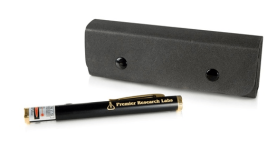MitchJi
10 MW
Hi,
I frequently need to use one of these Galaxy (multiple beams) Laser Pointers:

The reason I want to use a larger battery is that, the Laser Pointers work well with fresh alkaline cells at 1.62v. But when the cells get to about 1.48v Laser Pointers only work well for about 20-30 seconds, then get very, very dim. Since the nominal voltage of the alkaline cells is 1.5v and the Lasers draw about 30mW I think that's after about 20 minutes of use. I really don't like the combination of short life and non-rechargeable batteries so I'd like to use it with a single A123 18650 cell.
I got the following from the manufacturer:
1. Buy one of these for a cell holder (probably overkill - but I want the cell enclosed and I can get an LED module and end up with a flashlight Laser pointer combo):
http://www.lighthound.com/Solar-For...650--L2P-Host-HA-III-Black-Finish_p_3473.html
3. Wires will go to the end of the 18650 in the Solar Force L2 Host.
4. Use a Voltsphreak 2 amp charger to charge single (or 2 in parallel) A123 18650's.
5. Run the flashlight for a few seconds before using the laser pointer to get the cell down to 3.3v.
If you think you have a better idea (for the whole project or a individual part of it) please post it.
Thanks!
I frequently need to use one of these Galaxy (multiple beams) Laser Pointers:

The reason I want to use a larger battery is that, the Laser Pointers work well with fresh alkaline cells at 1.62v. But when the cells get to about 1.48v Laser Pointers only work well for about 20-30 seconds, then get very, very dim. Since the nominal voltage of the alkaline cells is 1.5v and the Lasers draw about 30mW I think that's after about 20 minutes of use. I really don't like the combination of short life and non-rechargeable batteries so I'd like to use it with a single A123 18650 cell.
I got the following from the manufacturer:
My tentative plan is to (unless someone chimes in with a better idea):Normally Green laser pointer designed for operation voltage 2.8~3.2V...
My engineer do confirm that our Green laser pointer can’t be allowed to use voltage >3.3V, it may damage our pointer.
1. Buy one of these for a cell holder (probably overkill - but I want the cell enclosed and I can get an LED module and end up with a flashlight Laser pointer combo):
http://www.lighthound.com/Solar-For...650--L2P-Host-HA-III-Black-Finish_p_3473.html
2. Use a wood dowel in the laser pointer the length and diameter of 2aaa's with wires on the ends, going through a small hole I'll drill in the end cap.Your Price: $22.99
NOTE: This is NOT a complete flashlight. There is no bulb or batteries.
Features:
-Special edition of Solar Force L2 Host in Mil-spec type III hard anodized in black
Features:
* Flashlight host (head assembly + battery tube + tail switch assembly) without built/drop-in
* Made of aluminum alloy
* Uses both primary (CR123A) lithium or rechargeable li-ion (16340 or 18650) batteries (not included)
* Tail clicky switch
* Length x diameter (head and battery tube, mm): 140 x 32 x 25
3. Wires will go to the end of the 18650 in the Solar Force L2 Host.
4. Use a Voltsphreak 2 amp charger to charge single (or 2 in parallel) A123 18650's.
5. Run the flashlight for a few seconds before using the laser pointer to get the cell down to 3.3v.
If you think you have a better idea (for the whole project or a individual part of it) please post it.
Thanks!










